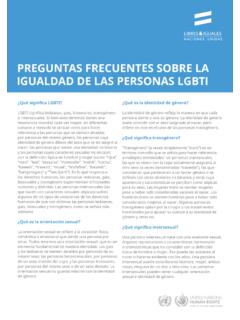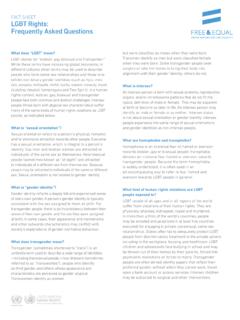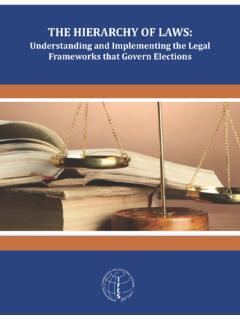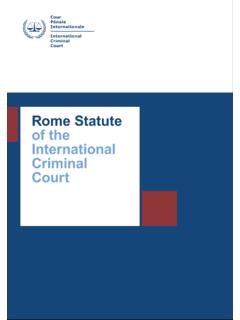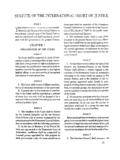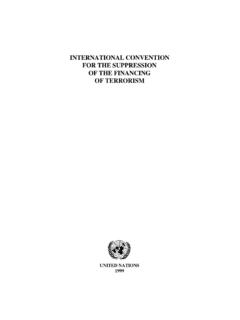Transcription of Fact sheet International Human Rights Law and Sexual ...
1 Fact sheet International Human Rights Law and Sexual Orientation & Gender IdentityWhat are Human Rights ? Human Rights are Rights inherent to all Human beings. We are all equally entitled to our Human Rights without discrimination, whatever our nationality, place of residence, sex, national or ethnic origin, color, religion, language, or any other status, such as age, disability, health status, Sexual orientation or gender identity. These Rights , whether they are civil and political Rights (such as the right to life, equality before the law and freedom of expression) or economic, social and cultural Rights (such as the Rights to work, social security and education) are indivisible, universal, interrelated and Rights were developed and articulated in the Universal Declaration of Human Rights (1948) as a response to the atrocities of World War II.
2 Universal Human Rights are often expressed and guaranteed by law, in the forms of treaties, customary International law, general principles and other sources of International law. International Human Rights law lays down obligations of Governments to act in certain ways or to refrain from certain acts, in order to promote and protect Human Rights and fundamental freedoms of individuals or groups. By becoming parties to International treaties, States assume obligations and duties under International law to respect, to protect and to fulfil Human Rights . The obligation to respect means that States must refrain from interfering with or curtailing the enjoyment of Human Rights . The obligation to protect requires States to protect individuals and groups against Human Rights abuses by third parties. The obligation to fulfil means that States must take positive action to facilitate the enjoyment of basic Human Rights .
3 What is International Human Rights law? International Human Rights law lays down obligations that States are bound to respect. Through ratification of International Human Rights treaties, Governments undertake to put into place domestic measures and legislation compatible with their treaty obligations and duties. Where domestic legal proceedings fail to address Human Rights abuses, mechanisms and procedures for individual complaints or communications are available at the regional and International levels to help ensure that International Human Rights standards are indeed respected, implemented, and enforced at the local level. At the International level these mechanisms include treaty bodies, expert committees established by treaty and tasked with monitoring implementation of treaty obligations, and special rapporteurs and other independent experts appointed by the United Nations Human Rights Council to investigate and report on pressing Human Rights challenges.
4 Is it ever legal to discriminate against lesbian, gay, bisexual, transgender or intersex people?No. The right to equality and non-discrimination are core principles of Human Rights , enshrined in the United Nations Charter, The Universal Declaration of Human Rights (UDHR) and Human Rights treaties. The opening words of the Universal Declaration of Human Rights are unequivocal: All Human beings are born free and equal in dignity and Rights . The equality and non-discrimination guarantee provided by International Human Rights law applies to all people, regardless of sex, Sexual orientation and gender identity or other status. There is no fine print, no hidden exemption clause, in any of our Human Rights treaties that might allow a State to guarantee full Rights to some but withhold them from others purely on the basis of Sexual orientation and gender , United Nations Human Rights treaty bodies have confirmed that Sexual orientation and gender identity are included among prohibited grounds of discrimination under International Human Rights law.
5 This means that it is unlawful to make any distinction of people s Rights based on the fact that they are lesbian, gay, bisexual or transgender (LGBT), just as it is unlawful to do so based on skin color, race, sex, religion or any other status. This position has been confirmed repeatedly in decisions and general guidance issued by several treaty bodies, such as the United Nations Human Rights Committee, the Committee on Economic, Social and Cultural Rights , the Committee on the Rights of the Child, the Committee against Torture, and the Committee on the Elimination of Discrimination against Women. What are some of the most common forms of Human Rights violations affecting LGBT people? The UN Human Rights office has documented a wide range of Human Rights violations committed against individuals on the basis of their Sexual orientation and gender identity.
6 These include: Violent attacks, ranging from aggressive verbal abuse and psychological bullying to physical assault, beatings, torture, kidnapping and targeted killings. Discriminatory criminal laws, often used to harass and punish LGBT people, including laws criminalizing consensual same-sex relationships, which violate Rights to privacy and to freedom from discrimination. Discriminatory curbs on free speech and related restrictions on the exercise of Rights to freedom of association and assembly, including laws banning dissemination of information on same-sex sexuality under the guise of restricting the spread of so-called LGBT propaganda. Discriminatory treatment, which can take place in a range of everyday settings, including workplaces, schools, family homes and hospitals. Without national laws prohibiting discrimination by third parties on grounds of Sexual orientation and gender identity, such discriminatory treatment continues unchecked, leaving little recourse to those affected.
7 In this context, lack of legal recognition of same-sex relationships or of a person s gender identity can also have a discriminatory impact on many LGBT have the UN General Assembly and Human Rights Council said on this subject?The United Nations General Assembly, in a series of resolutions, has called on States to ensure the protection of the right to life of all persons under their jurisdiction and to investigate promptly and thoroughly all killings including those motivated by the victim s Sexual orientation and gender identity (see, for example, resolution A/RES/67/168).In June 2011, the United Nations Human Rights Council became the first UN intergovernmental body to adopt a wide-ranging resolution on Human Rights , Sexual orientation and gender identity. Resolution 17/19 expressed the Council s grave concern at violence and discrimination against individuals based on their Sexual orientation and gender identity, and commissioned a study on the scope and extent of these violations and the measures needed to address requested study, prepared by the Office of the High Commissioner for Human Rights , was released in December 2011.
8 It pointed to a pattern of violence and discrimination directed at individuals because of their Sexual orientation and gender identity. Its findings and recommendations formed the basis of a panel discussion that took place at the Council in March 2012 the first time a formal intergovernmental debate on the subject had been taken place at the United practical steps does International law require States to take in order to safeguard the Rights of LGBT people?The core legal obligations of States with respect to protecting the Human Rights of LGBT people include obligations to: Protect individuals from homophobic and transphobic violence and prevent torture and cruel, inhuman and degrading treatment. Enact hate crime laws that discourage violence against individuals based on Sexual orientation, and set up effective systems for reporting hate motivated acts of violence, including effectively investigating, and prosecuting perpetrators, bringing those responsible to justice.
9 Provide training to law enforcement officers and monitor places of detention, and provide a system for victims to seek remedies. Additionally, asylum laws and policies should recognize that persecution based on Sexual orientation may be a valid basis for an asylum claim. Repeal laws criminalizing homosexuality including all legislation that criminalizes private Sexual conduct between consenting adults. Ensure that individuals are not arrested or detained on the basis of their Sexual orientation or gender identity and are not subjected to any degrading physical examinations intended to determine their Sexual orientation. Prohibit discrimination based on Sexual orientation and gender identity. Enact legislation that prohibits discrimination on the grounds of Sexual orientation and gender identity. Provide education and training to prevent discrimination and stigmatization of LGBT and intersex people.
10 Safeguard freedom of expression, association and peaceful assembly for all LGBT people and ensure that any restrictions on these Rights even where such restrictions purport to serve a legitimate purpose and are reasonable and proportionate in scope are not discriminatory on grounds of Sexual orientation and gender identity. Promote a culture of equality and diversity that encompasses respect for the Rights of LGBT
